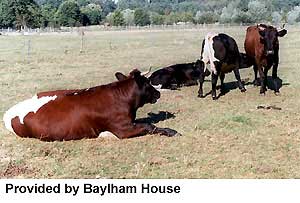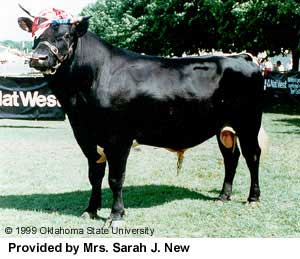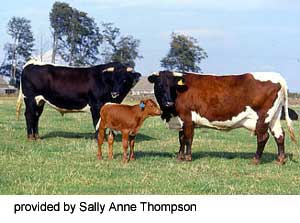Gloucester Cattle
Also known by: Gloucestershire, Old Gloucester, Old Gloucestershire
Gloucester Cattle are an ancient breed, numerous in the Severn Vale as early as the 13th century. They were valued for their milk (producing double Gloucester Cheese), their beef, and for producing strong and docile oxen. However, in the last two centuries, outbreaks of disease, the introduction of other breeds, and the development of intensive farming, led to such a reduction in their numbers that by 1972 only one herd remained. Fortunately, at its dispersal sale a group of purchasers determined that the breed should survive. It has done so. The Gloucester Cattle Society was revived and, since then cattle, numbers have increased from near extinction to over 700 registered females.
The cows are docile and amenable and respond well to individual care. They take well to hand milking and make ideal house cows. They have a flat lactation curve giving an even production for up to 300 days. This is kind to their udders and helps the longevity for which they are renowned, often breeding for 12 - 15 years.
Under appropriate management, the dairy strains will average 700 gallons per heifer and 8850 gallons per cow, with average butterfat of 3.9%, protein 3.3%, lactose 4.6%, which makes their milk ideal for farmhouse cheese. Gloucester milk, when produced alongside other breeds kept in the same conditions, is found to have a consistently lower bacteria count.
Even the bulls merit the breed's reputation for docility. They are active and get cows in calf to a tight calving pattern.
Gloucester steers produce a lean, quality carcass, with sufficient marbling of fat within the meat to give excellent flavor. Calves grow fast o the high quality milk of their dams and, under intensive systems, can finish by 2 years at a good killing-out ratio of around 52-54%. When fattened on grass they should finish within 3 years.
The management of Gloucesters fits well into an extensive system. Furthermore, providing the land drains well and they have some shelter and a dry bed, they will thrive if out-wintered, growing a good protective coat.
The Gloucester is a Dial Purpose Breed and therefore attention should be paid to both milk producing characteristics and body conformation. They are black brown with black head and legs, a white tail and a white streak down the back and a white underline. They have a dark muzzle with dark skin around the eyes and nose. Cows horns are fine, wide and inclined to turn up with black tips. The males weigh 750 kg, on average, and the females weigh 500 kg.
The breed is an irreplaceable part of our living heritage which should be preserved for future generations. The qualities of the Gloucester cattle give good reason for this preservation.
References
Gloucester Cattle Society, Secretary. Mrs S.J. New, Glebe Farm, Black Bourton, Bampton, Oxon, UK. OX18 2PP Tel/FAX; 01993 846600
Genus Bos: Cattle Breeds of the World, 1985, MSO-AGVET (Merck & Co., Inc.), Rahway, N.J.
Mason, I.L. 1996. A World Dictionary of Livestock Breeds, Types and Varieties. Fourth Edition. C.A.B International. 273 pp.



